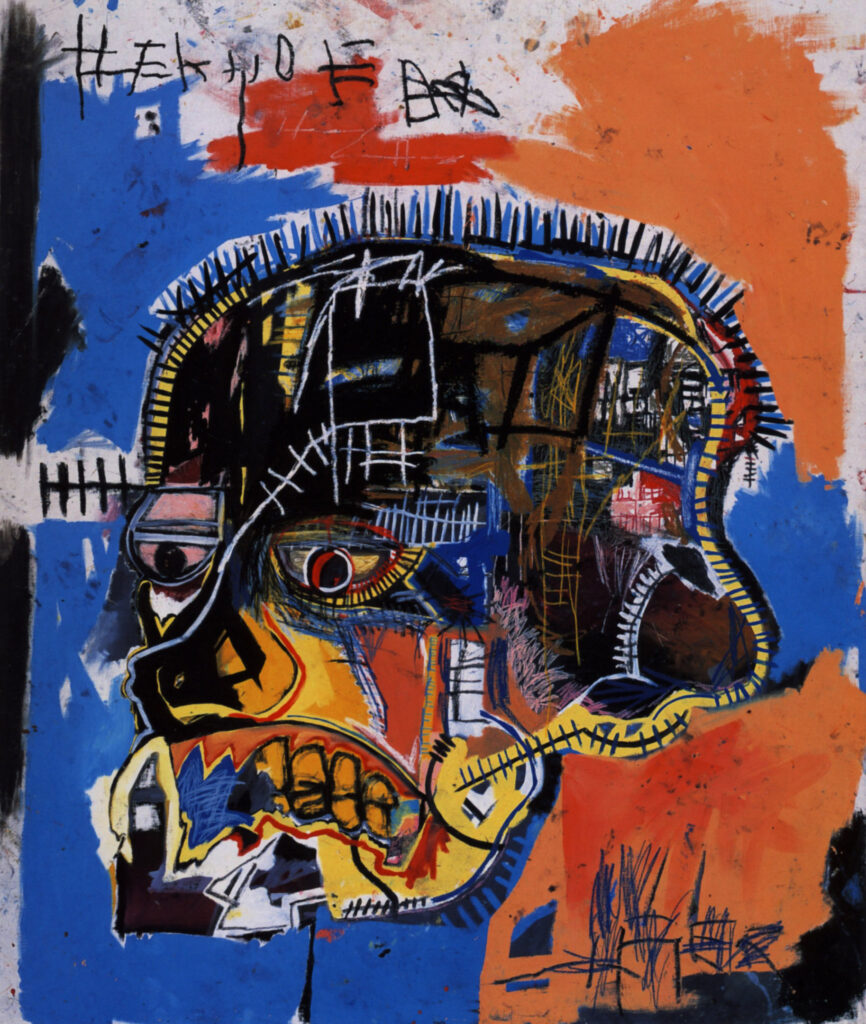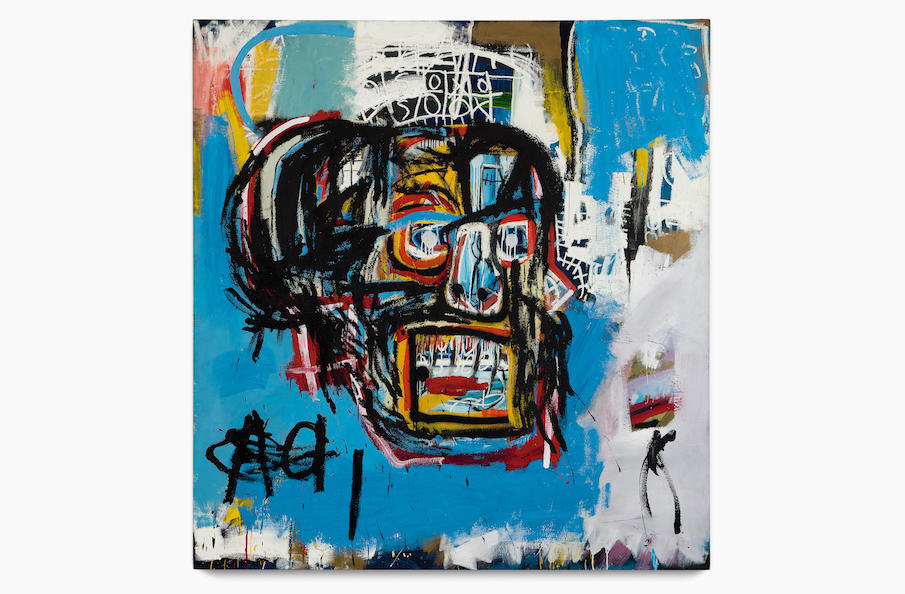Hey there, art aficionados! Get ready to embark on a colorful and thrilling journey through the iconic works of Jean-Michel Basquiat, the art world’s rebel with a spray can and a whole lot of attitude. Basquiat’s creations are like a dazzling mixtape of graffiti, street art, and neo-expressionism, and they’re going to blow your mind. In this article, we’re diving headfirst into Basquiat’s world by taking a closer look at ten of his most famous artworks. We’ll not only explore their creation dates, dimensions, and current whereabouts but also bring out the fun side of these masterpieces.
1. Untitled (1981)

| Date Completed | 1981 |
| Dimensions | 20 x 26 inches (50.8 x 66 cm) |
| Location | Safely tucked away in a private collection |
“Untitled” from 1981 serves as an entrancing gateway into Basquiat’s artistic universe. It is a remarkable encapsulation of his early exploration of the juxtaposition of text and imagery. Basquiat’s characteristic graffiti-style strokes create a sense of immediacy and a visual cacophony that begs for interpretation. The cryptic text seems to whisper secrets, inviting viewers to decode its hidden messages and join the artist in his quest for deeper meaning. This Basquiat’s masterpiece was completed in the year 1981.
2. Boy and Dog in a Johnnypump (1982)

| Date Completed | 1982 |
| Dimensions | An impressive 72 x 48 inches (182.9 x 121.9 cm) |
| Location | Enjoying its place of honor at The Broad in Los Angeles |
“Boy and Dog in a Johnnypump” is a colossal artwork that beckons you to dive headfirst into Basquiat’s world of symbolism and boundless imagination. The painting portrays a young boy and his loyal canine companion seemingly trapped within the confines of a soda bottle. This poignant work uses vibrant colors and a confined setting to evoke a sense of childhood wonderment and isolation. It’s an artistic rollercoaster that invites viewers to break free from the bottle and run like the wind.
3. Untitled (Crown) (1982)

| Date Completed | 1982 |
| Dimensions | 68″ x 48″ |
| Location | Whitney Museum of American Art, New York |
“Untitled (Crown)” is an iconic piece that features one of Basquiat’s signature motifs, the crown. This symbol, often repeated in his work, has been interpreted in various ways, from representing power and authority to the artist’s own sense of self-worth. The Whitney Museum is fortunate to house this remarkable artwork.
4. Hollywood Africans (1983)

| Date Completed | 1983 |
| Dimensions | A jaw-dropping 12 x 24 feet (365.8 x 731.5 cm) |
| Location | Holding court at the Whitney Museum of American Art in New York |
“Hollywood Africans” is a monumental artwork that encapsulates Basquiat’s exploration of racial identity and the stereotypes associated with African Americans in the media. In this larger-than-life painting, three iconic figures, Basquiat, Toxic, and Rammellzee, take center stage. They challenge the status quo and redefine their own narratives in a world that often seeks to confine them to predefined roles. This artwork is a visual declaration of self-determination and an invitation for viewers to question preconceived notions about identity and representation.
5. Untitled (History of the Black People) (1983)

| Date Completed | 1983 |
| Dimensions | A grand 84 x 60 inches (213.4 x 152.4 cm) |
| Location | Safeguarded in the private gallery of a fortunate owner |
“Untitled (History of the Black People)” is a powerful work that delves deep into Basquiat’s exploration of African and African American history. This painting is a rich tapestry of symbols, text, and imagery, weaving together the complex and often untold stories of Black people throughout history. It’s a testament to Basquiat’s commitment to shedding light on overlooked narratives and celebrating the resilience and contributions of Black individuals.
6. Irony of Negro Policeman (1981)

| Date Completed | 1981 |
| Dimensions | A sizable 48 x 48 inches (121.9 x 121.9 cm) |
| Location | Making waves at The Broad, Los Angeles |
“Irony of Negro Policeman” is a thought-provoking masterpiece from Basquiat’s early career. It delves into the dynamics of power, race, and identity. The picture features a Black police officer surrounded by graffiti and enigmatic text, challenging viewers to consider the complexities of race relations and the inner conflicts faced by many African Americans. Basquiat’s bold strokes and impactful symbolism make this artwork a compelling conversation starter.
7. Untitled (1982)

| Date Completed | 1982 |
| Dimensions | A substantial 60 x 60 inches (152.4 x 152.4 cm) |
| Location | Kept under lock and key in a private collection |
“Untitled” from 1982 is a mesmerizing drawing that showcases Basquiat’s mastery of layering text and imagery to create a multifaceted visual experience. The artwork is a complex and dynamic fusion of symbols and abstract forms that beckon viewers to engage with it on a deeply personal level. Basquiat’s ability to combine the culture and the emotional in a single canvas is evident in this work, making it a visual puzzle that begs to be solved.
8. Per Capita (1981)

| Date Completed | 1981 |
| Dimensions | A modest 20 x 24 inches (50.8 x 61 cm) |
| Location | Having a blast at the Museum of Contemporary Art in Los Angeles |
“Per Capita” is Basquiat’s way of shining a spotlight on the interplay between wealth and inequality. The painting features a skeletal figure surrounded by a whirlwind of symbols, creating a stark reminder of the disparities that exist within society. Basquiat’s choice of a skeleton as the central figure serves as a poignant reminder of the transience of wealth and the relentless march of time.
9. A Panel of Experts (1982)

| Date Completed | 1982 |
| Dimensions | A considerable 60 x 48 inches (152.4 x 121.9 cm) |
| Location | Hidden away in the private realm of a collector |
“A Panel of Experts” is like a visual symposium where authority figures don sharp suits but wear enigmatic expressions. Basquiat’s exploration of the credibility and intentions of those in positions of power is evident in this artwork. It’s like a visual puzzle where viewers are encouraged to dissect the meaning behind the imagery and text, all while questioning the role of “experts” in our society.
10. Famous Negro Athletes (1981)

| Date Completed | 1981 |
| Dimensions | A sizable 60 x 60 inches (152.4 x 152.4 cm) |
| Location | Taking a victory lap in the private collection of a lucky owner |
“Famous Negro Athletes” is a vibrant and dynamic celebration of Black sports legends who have risen above adversity to achieve greatness. This picture is a riot of colors and movement, like a stadium full of cheering fans. It serves as a reminder of the indomitable spirit and strength of the Black community, and it encourages viewers to join in the celebration of these extraordinary athletes.
Frequently Asked Questions
Why is Basquiat so famous?
Jean-Michel Basquiat’s remarkable artwork and captivating demeanor contributed to his rise to fame. He swiftly established himself as a cultural figure, personifying the New York City art scene of the 1980s and beyond. He was brave, innovative, and motivated.
Why is Basquiat art so expensive?
According to the New York Times, “a combination of raw talent, compelling biography, and limited supply” has always been what makes Basquiat’s art so appealing. Maybe this is the recipe that has drawn the billionaire art collectors’ bank accounts.
How many are Basquiat paintings worth?
On the high end, Basquiat’s paintings can fetch up to $100 million in auction, whereas items like screen-printed skateboards can be purchased for a few hundred dollars. When it comes to any number of Basquiat pieces, there is a broad variety in between.
Conclusion
Jean-Michel Basquiat’s art isn’t just a collection of canvases; it’s a vibrant and immersive exploration of life’s complexities and mysteries. Each of these masterpieces is a portal into Basquiat’s mind, offering a rich tapestry of symbols, stories, and social commentary. From the enigmatic and thought-provoking to the bold and celebratory, Basquiat’s art invites viewers to embark on a journey of interpretation and immerse the viewers in a sort of exhibition. So next time you find yourself in the presence of a Basquiat masterpiece, dive in, unravel the layers, and enjoy the kaleidoscope of meaning within each stroke of genius.













